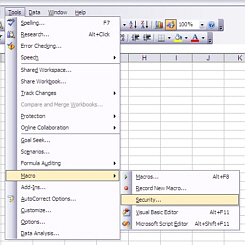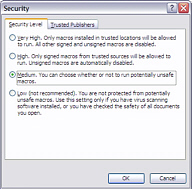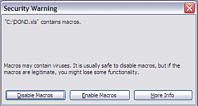|
 any people don't realise the inherent power of spreadsheets - they think
they're just for storing tables full of data that might be needed some day
by their boss. But with a bit of
imagination
and some
VB macros
in the background you can
shake off those static tables and two dimensional graphs and achieve almost
anything you want! If
you're fed up with mind-numbing
lists of meaningless data and want to add a
bit of ZING! to your Excel spreadsheets then
look no further! any people don't realise the inherent power of spreadsheets - they think
they're just for storing tables full of data that might be needed some day
by their boss. But with a bit of
imagination
and some
VB macros
in the background you can
shake off those static tables and two dimensional graphs and achieve almost
anything you want! If
you're fed up with mind-numbing
lists of meaningless data and want to add a
bit of ZING! to your Excel spreadsheets then
look no further!

Here you'll
find a collection of useful (and admittedly not-so-useful) spreadsheets that
go beyond the ordinary. While you can take all of them away and use them as
is, some of them don't have much practical use - they're just for fun. They're all
completely FREE for you to download and use as you wish...build, butcher or trash -
whatever you want!
 Q: "What's a
VB macro when it's at home?" Q: "What's a
VB macro when it's at home?"
A:
A macro is a piece of code running behind an application
such as Word or Excel that manipulates the document in ways that wouldn't
normally be available using only the normal user interface. Macros are
triggered by events happening in the document, like a cell being updated, a
paragraph being added, etc. If you've heard the term 'event-driven' that's
what it's referring to. A VB macro is one that's written in Visual Basic, as
they are in Word and Excel. In Excel macros are saved as part of the
workbook, and in addition to the code associated with the workbook as a
whole, every worksheet can have its own associated macro code.
Here's some
macro code that starts a clock when the workbook is opened:
Private
Sub Workbook_Open()
' Very first call to start the timer
UpdateClock
End Sub
The
procedure UpdateClock()
would probably do something a bit smarter, like keeping a clock ticking
in the spreadsheet:
Sub
UpdateClock()
'
Write the current time to cell A1
Worksheets("Clock").Range("A1") = Now
' Reschedule another update in one second
Application.OnTime Now + _
TimeValue("00:00:01"), _
"ThisWorkbook.UpdateClock"
End Sub
 The
first call writes the value of the
system time into the spreadsheet and the second call reschedules another
update in one second's time. As you can see this achieves something that's
impossible to do in a normal Excel formula - a clock that ticks away in cell A1 as
you edit the rest of the spreadsheet. Take a little time to learn about
macro programming and you can make your spreadsheets infinitely more
powerful! The
first call writes the value of the
system time into the spreadsheet and the second call reschedules another
update in one second's time. As you can see this achieves something that's
impossible to do in a normal Excel formula - a clock that ticks away in cell A1 as
you edit the rest of the spreadsheet. Take a little time to learn about
macro programming and you can make your spreadsheets infinitely more
powerful!
Q: "Do these
free spreadsheets
contain harmful code that could damage my computer?"
A:
Nope. But if you want to put your mind at ease, set Excel's macro security level to Medium
by selecting Tools > Macros > Security... like so:


When the
spreadsheet loads you'll be asked whether or not you want to run macros -
select Disable Macros:

You can then
view the macro code by pressing ALT-F11 to bring up the Visual Basic editor. To
run the spreadsheet properly you'll have to shut the VB editor, quit the
spreadsheet and reload it, this time selecting Enable Macros.
Q: "These
are great! Why are
you giving them away?"
A:
Why not? They've helped me understand the various
aspects of Excel in some way other and if they can
help you too, great. If not, then nothing
lost!
Q: "Amazing! How much
do they cost?"
A:
About 3 seconds of your time to wait for the download.

|